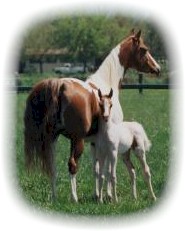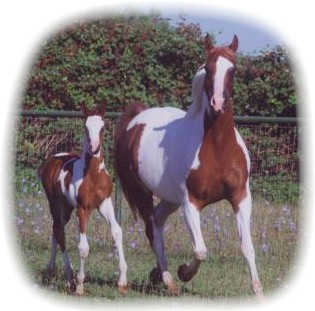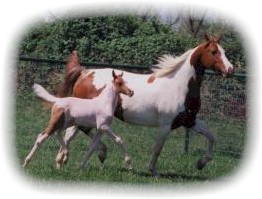
The Homozygous Tobiano
 |
Color and Flash, "Chrome" on a horse has always had its appeal to contestant, judge, or equine admirer. But today one of the hottest happenings in the equine world is the pinto coat pattern. Topping most horse sales across America is the flashy marked spotted horse, showing that even though color isn't everything, given similar quality (and sometimes less) the "color" sells twice or three times as high. Given this growing popularity, the homozygous Tobiano deserves a closer look and understanding by the professional breeder or backyard enthusiast breeding any breed of horse. Homozygous: In genetics, an animal or plant whose chromosomes contain an identical pair of genes and which, therefore, always breeds true to type. The word homozygous is becoming more and more common, but still is often misunderstood, misused, and misadvertised. The above definition applied to coloration of horses is scientifically very complex but in practical use very simple. A double-gened homozygous Tobiano is genetically able to produce colored pinto babies every time, no matter what color the other parent. Every horse, mare or stallion, inherits one color gene from each of its parent, but will only pass on one of those to its offspring. The double-gened Tobiano will then pass on only a pinto/color gene every time-- which dominates any other solid color gene passed on by the other parent, resulting in a pinto spotted foal. A heterozygous Tobiano stallion, on the other hand, has one pinto gene and one solid gene. A toss of the coin will be the odds for him passing his pinto gene or his solid gene. Bred to a solid mare he then has a 50/50 chance of producing color. The obvious problem here is the 50% chance of solid when the breeder is hoping for a colored foal and disappointment is met after nearly a year's long wait. The homozygous ends these disappointments. With color becoming ever more popular, finding a quality homozygous pinto stallion can be a bonanza for owners and breeders with solid mares. It should be noted that the popular Overo pattern, as defined by the APHA, cannot be homozygous. When double Overo genes are produced in an offspring, the lethal white genetics result in the death of the foal. Therefore, the Overo pattern is a 50/50 proposition at best on solid mares, because even if the Overo gene is passed on, a color pattern may not be presented because the gene is recessive. Crossing two Overo horses then runs a 25% risk of the lethal white foal. There is much to be studied and learned about equine color genetics which this article does not explore. It does, however, relate to you the breeder what it takes to rest assured all year long that you do indeed have a colorful pinto foal "in there"! Ann Bowling, head of the Spotted Horse Genetic Research Group of UC Davis, has approved the technical data contained in this report.
|
 |
|
 |
|
 |
